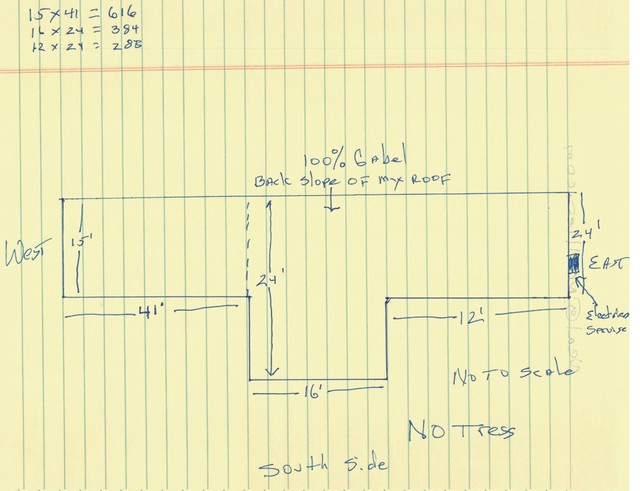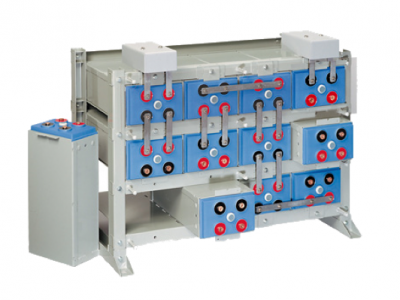We now know a bit more about Will’s roof, his power consumption and what he wants to do. Let’s get started…on some Texas-sized solar power.
I’ve been in contact with Will and he supplied some more information. If you read Part 1, you know he wants to go with solar power, but that leaves a lot out. We now know that he has a big house, 3700 sq. ft., and pool. He also has a Texas-sized power bill and wants to go off grid before he retires.
Let’s start with his power bill, a bit over $300. We don’t know the kilowatt-hours he uses, but we can come pretty close from the bill. “A bit over” can cover the base fee, leaving $300 even. Another Texan, Donald, tells me his power costs a dime per KWH. So .10 into $300 gives us 3000 KWH.
That’s a bit more than most folks, but I am told a pool can take up $100 worth of power. I don’t know much about pools, but I am aware there is a pump and often a heater. I wonder if the pump could be put on a timer to only run during the day when the sun is working? I don’t know how Will is heating the pool. I know he has natural gas. That’s the way to go OR use a solar thermal heater. That is relatively inexpensive and there is no fuel cost.
Regardless, 3000KWH divided by 30 days in a month, gives you 100KWH of power per day of consumption, which is an easy number to use.
We don’t know his average hours of insolation (not inSUlation), but he can look that up on numerous websites, but lets go with 5 hours, as he is at a similar latitude to my place. Divide your daily 100KWH by your presumed 5 hours of full effective sunlight and that means you need 20KW of solar.
When we say 5 hours of insolation, you know you’ll be getting a little bit at 7am, a lot at noon, and a little at 5pm. That’s 10 hours of some amount of sunlight and factors in the average and some cloud time. It isn’t perfect, but you have to start somewhere!
If you find a deal on 250 watt panels, divide 250 into 20,000 (remember, it was 20 KILO, or thousand watts) and that comes out to be a whole bunch…80 panels. Oh my, that’s gonna take a lot of roof. Let’s run that again with some of the newer, more efficient panels. I have some 300 watt panels that are the same width as a 250 and maybe and inch or two shorter. 300 into 20,000 gives us a need for 67 panels. That’s a lot less, but still a bunch. 400 watt panels are becoming more common. I saw where one company just announced a 440 watt panel, but I doubt you can buy them yet. Let’s try 400 into 20,000 and you get a more manageable 50 panels. However, these are going to be bigger panels.
We’re now at the point where an old boss of mine said we’d “play with paper dolls.” This was before computer CAD programs. We’d take a piece of graph paper and draw out the roof, in this case, to some convenient scale. Next, using the same scale, we’d cut out 50, or 67, or 80 paper panels to scale (starting out in strips) and then start shuffling the paper panels around on the paper roof to see IF they’d all fit and HOW’d they best fit. A good scheme is to butt together two rows, skinny sides together, then leave some walk space, unless you want people walking around on your panels. If fact, I think the Code now requires that you leave some walking around room. In two row sets you can get at them for troubleshooting or service if you should ever have a weather (hailstones or hurricanes) or electrical issue (lightning, hotspots, hungry squirrels). If you use CAD at work, then you are already prepared to make a roof model on your lunch hour. There are even free CAD programs that you can download and learn to use at home. We didn’t have CAD when I went to engineering school, so I am comfortable with a pencil and a bit of graph paper, but I designed a bunch of computer stuff using CAD, too. Your choice.
Looking at a sketch of Will’s roof, it seems to be 69′ long and facing south. You couldn’t ask for a better start! Let’s see, those 300 watt panels are a meter wide, let’s call it 40 inches. 69′ is 828″. 828 divided by 40 is about 20 panels wide, not counting a useful walkway. One thing that concerns me is a dashed line. I’m thinking that represents something like we have at Mom’s house. There, you have one level of roof over the living area, then it steps down 2 feet across the double carport and the garage. If there is a stepdown, depending which way it goes, there’s going to be some shading going on early morning or late afternoon. You’d best leave some panels out to avoid the shade. Shading a panel can do more than just reduce your power. We won’t talk about that right now, but it isn’t a good thing. Let’s assume a shady area and leave a panel or two out for a walkaround.
Can we do more rows, because it looks like we’re short? Yup, he has 24 feet of slope. Let’s just say a solar module is 6′ tall. Most aren’t but that’ll give us some margin. 3 rows is then 18′, leaving 6 feet to divvy up for walkways. Let’s just say we took out two panels for our presumed shade, leaving 18 to the row. Three rows make room for 54 panels. Not enough for 300 watt panels, so we might want to consider the 400 watt class. Download a spec sheet to make your paper dolls, either the literal kind or the virtual ones.
Oh, but no worry. Aside from that long stretch of 24 feet, he has an extension in the middle. It is 16 x 24, which could give him maybe 3 more rows of 4 panels, bringing the total to 66. We have this licked!

Ok, understand that solar panels are rated for certain standards for conditions. Unless they are on a mountain top, free of haze and running cool, they are not going to put out full rated power. Also, understand that things may change and you’ll want more power. Think ahead and leave yourself some margin.
What I am thinking here is to fill every one of those rows up with 335 watt panels, assuming the scenario I have described will play out. Where’d we leave off? About 66 panels? 335 watt panels are cheap and plentiful and 66 of them will make (ideally) 22KW. Multiply by 5 and we have 110KWH, giving us a 10% margin. Hey, if you can get more up there, go for it. Trust me, except when it comes time to write the purchase check, you won’t complain about having more than enough power.
OK, we’ll leave Will to check the numbers for how many he can get up there without shading and check on walkway requirements in the local code. I think this will work.
Next time we’ll talk about something else that is very important: the big, ginormous battery. Will’s going to need one.

The Texas-sized power system in the photo at the top of the page comes from Daryl T.
UPDATE: Wouldn’t you know it, I say 335 watt panels are cheap and plentiful and then find John is out of them! He has plenty of 320 watt panels, but I think 66 of them will cut it too close. The big surprise is the deal on some of the newfangled half-cut 385 watt panels. They will give lots of margin and cost less than the 320w modules! Available in pallets, only, but Will is going to need pallets. Call Sun Electronics for a spec sheet to get the size.
–Neal
